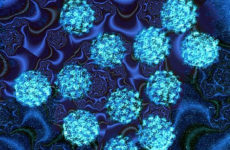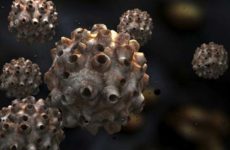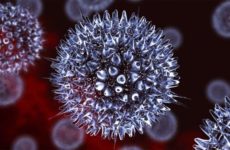Papillomavirus infection (PVI) – belongs to the group of anthroponotic pathogens (transmitted exclusively from person to person).
The path of infection is determined by several options for the development of events: through sexual contact, through blood, by household means (with a latent form of the disease – “warty”).
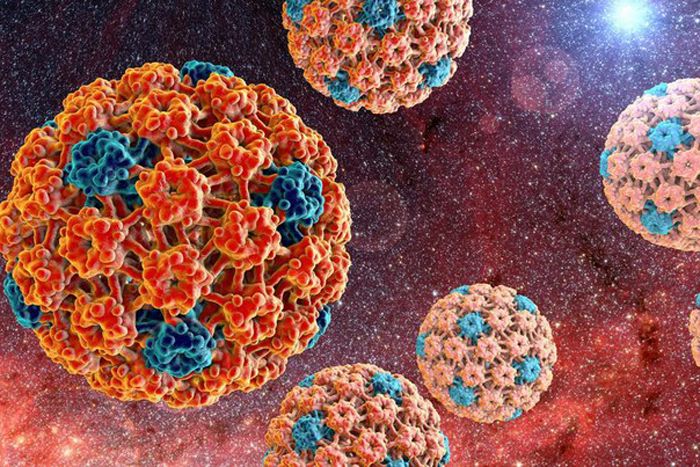
Содержание:
Methods of infection
As mentioned above, there are only three main ways of infection – through sexual contact, through blood, by household means.
Penetrating through the protective barrier of the skin, mucous membranes, the circulatory system, HPV has an extremely negative impact on the patient’s health.
Typically, a person experiences:
- Constant weakness.
- Feeling of nausea, heaviness in the hypochondrium.
- Pain syndrome.
- Problems with the urinary and reproductive system (difficulties with urination, the appearance of sharp paroxysmal pain in the perineum).
- Burning sensation in the groin.
- Dizziness against the background of a frequent rise in body temperature.
- A general decrease in the protective functions of the body (frequent colds, a long recovery period after an illness).
- Skin itching, which is accompanied by the appearance of papilloma .
In order to recognize the presence of a viral infection and consult a doctor in time, it is necessary to take into account the prerequisites for the occurrence of this disease. We recommend that you familiarize yourself with the material: papilloma ICD 10 .
Prerequisites for infection
The most common prerequisites for the occurrence of HPV include:
- Weakened immunity.
- The presence of other chronic diseases that undermine the body’s resistance to all kinds of attacks from outside.
- We are talking about hepatitis, human immune deficiency (HIV), cardiovascular diseases, genetic anomalies, rare hereditary forms of the disease.
- Promiscuous sexual relations.
- Unprotected sexual contact.
- Infection from a loved one in everyday life: when using dishes, bed linen, towels, with a kiss, hugs.
- Use of public places of culture and recreation.
- Visiting beauty salons.
- Sharing personal items: combs, manicure accessories.
Transmission routes
The papilloma virus is transmitted through bodily contact, transplacental (transplanted from infected surfaces), with the help of cerebrospinal fluid (blood, saliva, sweat).
Therefore, if there is a sick person in the family, it is necessary to constantly treat all surfaces with a special antiseptic, follow strict rules regarding personal contacts and monitor the condition of the skin (even microcracks can become the initial area of damage).

Can HPV be contracted through household contact?
Papillomavirus infection is perfectly transmitted through common objects, as well as with saliva. This should not be forgotten if there is a sick person in the house.
Distribution mechanism:
- Kissing, hugging. With saliva and sweat, PVI passes from one person to another. This is possible due to the fact that the virus moves freely through the mucous membranes, is present in saliva and cerebrospinal fluid.
- When using personal hygiene items belonging to the patient.
- When shaking hands. Microtraumas of the skin can be excellent conductors of infection.
- When using shared utensils.
- When transferring things, objects from an infected person to a healthy person (this type of infection is very resistant to the influence of environmental factors).
Can HPV be transmitted sexually?
Since the mucous membranes, skin and their derivatives (secretions, blood vessels, saliva) are carriers of genetic material, it is possible to become infected with human papillomavirus through sexual contact; as well as when using public baths, saunas.
Transmission mechanism:
- Directly during sexual contact (this is especially true for oral and anal sex).
- When using shared showers, baths, saunas. Without proper antiseptic and antibacterial treatment, such places are breeding grounds for all kinds of infections.
- When using underwear and clothes of a partner (especially for women who like to wear men’s shirts, T-shirts, shorts, family shorts).
Is the virus transmitted from mother to child?
The transmission of infection from mother to child is called the “vertical transplant route”. This type of papillomavirus transmission is one of the most dangerous, as it injures the child’s body and intellect.
After suffering HPV, especially in the early stages (1 trimeter), doctors insist on an abortion for medical reasons.
Autoinfection
Self-infection is possible only if untreated hygiene items are used. For example: razors, toothbrushes, nail scissors and similar items.
With this form of transmission of the papillomavirus, the patient does not feel discomfort for a long time and leads a normal life. And when the first symptoms of the disease appear (which are very similar to banal overwork), he ignores them without going to the doctor.
What types of HPV are the most dangerous?
The most dangerous types of Human Papilloma Virus (HPV) include types 16 and 18. They have strains that provoke the appearance of malignant neoplasms – cancerous tumors that, when growing, can give metastases.
The most common manifestation of the impact of a strain of the virus is the occurrence of such diseases as: cervical cancer, infertility, pulmonary and bronchial changes, an acute shortage of immunoglobulins.
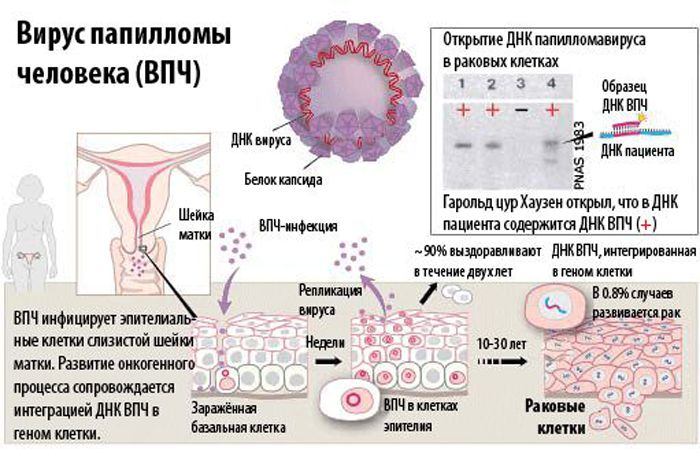
Diagnostics
To detect the presence of the Human Papilloma Virus (HPV) in the body, a number of the most complex hardware techniques help.
- Colposcopy. A colposcope is a medical device that allows you to accurately determine changes in the mucous membranes of the genitourinary system: to detect inflammation, damage and the spread of viruses, fungal bacteria. Its use to determine the presence of HPV in the body is used to finally confirm the diagnosis. This device is capable of: under 30-fold magnification, find the source of inflammation, determine its nature, take a scraping directly in the affected area.
- PCR examination. This laboratory method is a differential diagnosis of this type of disease. PCR makes it difficult to determine the type of virus, but also the route of infection. For this analysis, biomaterial sampling is required: blood, urine, sperm.
- Digene test. A modern diagnostic technique based on the separation of a small area of the affected skin for study. Using this approach, medical specialists can say for 100% what type of virus is present in the body, what is its concentration, whether it is in a reactive form, to which antiviral drugs there is sensitivity.
- Cytology. It is a study of the problem at the cellular level. For this, the upper layer of the papilloma is removed, a separate section of the mucous membrane is taken. With the help of a heavy-duty microscope and a basic set of reagents, laboratory assistants study the behavior of the virus, its effect on the body (make a forecast), the degree of damage to the internal systems of the body.
- Histological diagnosis. The purpose of this technique is to study morphological changes in tissues. Material for the study is taken using a biopsy.
Treatment
Treatment of Human Papilloma Virus involves strict observance of sexual abstinence, the use of broad-spectrum antibiotics, immunomodulating drugs, vitamin complex, drugs to reduce the effect of the virus on the body.
You should also limit the access of healthy people to personal belongings, hygiene products, dishes and bedding. When malignant neoplasms caused by a virus appear, corrective treatment or surgical intervention with a long rehabilitation period is carried out.
Ways to prevent the disease
The main ways to prevent HPV are:
- Compliance with the rules of sanitary and domestic provision of living space.
- The use of contraceptives.
- Control over the state of one’s own health from specialized specialists.
- The use of personal hygiene products strictly for their intended purpose, without transferring them to third parties.
- No trips to places of increased risk of infection: baths, saunas, swimming pools, water parks, massage and beauty salons.
- Protection of the skin from interaction with a large number of external factors.
- Protecting one’s own health by isolating from those who are sick with any infectious and viral diseases, skin diseases.
It is simply impossible to cope with a complex viral infection on your own. Medical control, timely appeal for qualified help to a wide group of specialists will be the very first and most serious step to deal with the existing problem.
If such a problem occurs, one of the family members should immediately undergo a routine diagnosis and follow all the doctor’s instructions in order to avoid the spread of the virus. In addition, we should not forget about the precautions that will help prevent infection.



